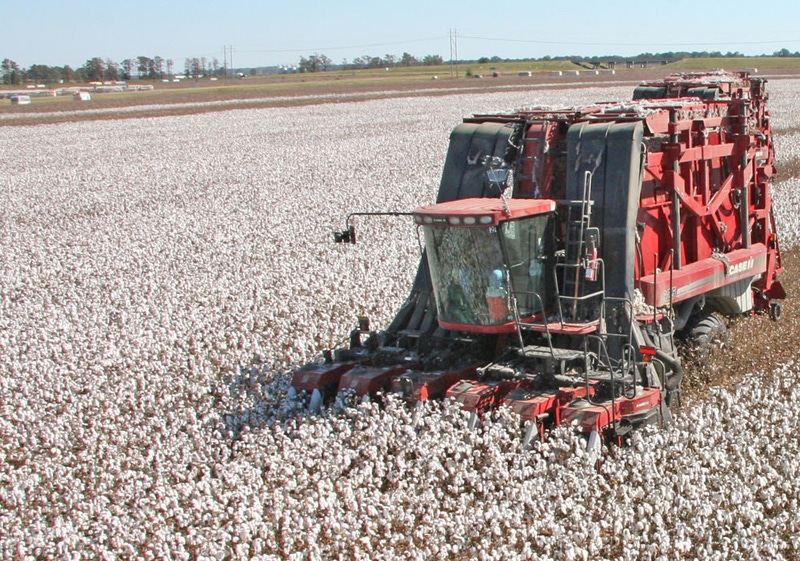
The 2013 U.S. cotton crop surpassed previous records for length and strength, according to USDA’s Agricultural Marketing Service, but the average leaf grade continues to creep higher as well.
According to Robbie Seals, director, USDA/AMS, Grading Division, Cotton and Tobacco Programs, the quality data was based on 10.9 million cotton bales classed of an estimated 12-million-bale crop. Most of the remaining cotton to be classed is in Macon, Ga., Abilene, Texas and Visalia, Calif. Click here for the latest AMS update.
Southeast had biggest crop in 2013
Seals reported that due to the last three years of drought, the Southwest has lost its position as the highest-producing region. Prior to the drought, Texas and other states comprising the Southwest typically produced half or more of the U.S. cotton crop, a percentage now down to 34 percent of the U.S. crop. Meanwhile, the Southeast has climbed to 37 percent. The Mid-South, at 22 percent, dropped in production and acres due better returns for corn and soybeans in 2013.
RELATED: New cotton varieties take on stress, bugs and nematodes
The percent of 2013 cotton with a color grade of 41/32 or higher was 92 percent, a slight decline from 94 percent in 2012. “Some of that drop was attributed to some of the lower quality we had in North Carolina and Virginia after heavy rain in the fall,” Seals said. “The Southeast is the only area where the color grade dropped significantly from last year.”
Leaf grade rises again
The average U.S. leaf grade continues to rise, going from 3.1 to 3.2, the highest since 2009. The Mid-South has led the increase, moving from 3.5 to 3.6 to 3.9 over the last three years.
The percentage of 5-leaf bales increased to 20 percent in the Mid-South, noted Seals. “Arkansas, Louisiana and Mississippi have really jumped up, as well as Tennessee, which is very unusual. Missouri is still between 3-leaf and 4-leaf.” About 11 percent of the U.S. crop was 5-leaf in 2013.
Meanwhile, extraneous matter is down from last year to 9 percent, and is down across all regions. Seals said the measurement could creep higher, as later classed cotton “typically has a little more extraneous matter. In the Far West, some of the late crop in Arizona and New Mexico tends to have a little more bark.”
The micronaire average for the United States dropped down to a 4.4, the lowest average since 2009, with significant decreases in the Mid-South and Texas.
But there was a marked division between south and north in the Mid-South, noted Seals, probably due to cooler weather and the shorter season. “The Rayville, La., classing office averaged right at 4.9, while Memphis had one of the lowest micronaire readings ever, right around a 4.5 or 4.6.”
The same could be said for west Texas, where cooler temperatures led to lower average micronaire north of Lubbock.
Long and strong
U.S. cotton producers grew the strongest fiber crop in the history of 100 percent HVI classing last year, averaging 30.3 grams per tex, Seals said. “In 1991, strength averaged 26.3. It has stayed right at 30 the last four years.”
The 2013 crop also reported the longest average staple ever, at 35.9, Seals said. However, average staple length declined in the Southwest due to three years of drought. “From 2005 to 2010, Texas was equal to or greater than the U.S. average staple. But these last three drought years, the staple length average has dropped in Texas.”
The percent of U.S. bales at basic quality and higher for 2013 was 47.5 percent, Seals said. That’s slightly above the 45.5 percent in 2012, but lower than 2011. “By region, the Southeast declined due to wet weather and light spot. The Mid-South improved from last year, while west Texas, Oklahoma and Kansas were slightly better than last year. There was very little change in the Far West.”
The percent of U.S. cotton measuring 31-3-35 (color-leaf-staple) or better averaged 28 percent in 2013, with the highest percentage in the Far West, followed by the Southwest, the Southeast and the Mid-South.
According to Seals, 99.3 percent of Pima cotton graded was Grade 3, “one of the highest quality Pima crops we’ve ever had. Staple length was 48.1 and strength continues to climb each year, and is the highest strength we’ve ever had, at 43.4 grams per tex.”
Ag news delivered daily to your inbox: Subscribe to Delta Farm Press Daily.
About the Author(s)
You May Also Like






